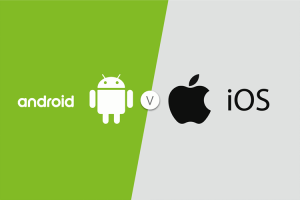What is an android?
Android is a mobile operating system developed by Google. It is based on a modified version of the Linux kernel and other open source software and is designed primarily for touchscreen mobile devices such as smartphones and tablets.
In addition, Google has further developed Android TV for televisions, Android Auto for cars, and Wear OS for wrist watches, each with a specialized user interface. Variants of Android are also used on game consoles, digital cameras, PCs and other electronics.
Android has been the best-selling OS worldwide on smartphones since 2011 and on tablets since 2013. As of May 2017, it has over two billion monthly active users, the largest installed base of any operating system, and as of December 2018, the Google Play store features over 2.6 million apps.
Android vs IOS
According to data, Android and iOS now account for a combined 99 percent of the worldwide smartphone operating system market. Android holds 86.2 percent of the market, up from 82.2 percent in the year-ago quarter. Combine that with the 12.9 percent iOS holds, and that’s 99.1 percent of the entire market.
What are the versions in android?
- Android 1.0: Android Alpha
- Android 1.1: Android Beta
- Android 1.5: Android Cupcake
- Android 1.6: Android Donut
- Android 2.0: Android Eclair
- Android 2.2: Android Froyo
- Android 2.3: Android Gingerbread
- Android 3.0: Android Honeycomb
- Android 4.0: Android Ice Cream Sandwich
- Android 4.1 to 4.3.1: Android Jelly Bean
- Android 4.4 to 4.4.4: Android KitKat
- Android 5.0 to 5.1.1: Android Lollipop
- Android 6.0 to 6.0.1: Android Marshmallow
- Android 7.0 to 7.1: Android Nougat
- Android 8.0 to Android 8.1: Android Oreo
- Android 9.0: Android Pie
Features
Interface
Android’s default user interface is mainly based on direct manipulation, using touch inputs that loosely correspond to real-world actions, like swiping, tapping, pinching, and reverse pinching to manipulate on-screen objects, along with a virtual keyboard.
Android home screens are typically made up of app icons and widgets; app icons launch the associated app, whereas widgets display live, auto-updating content, such as a weather forecast, the user’s email inbox, or a news ticker directly on the home screen.
Applications
Applications (“apps”), which extend the functionality of devices, are written using the Android software development kit (SDK) and, often, the Java programming language.
The SDK includes a comprehensive set of development tools, including a debugger, software libraries, a handset emulator based on QEMU, documentation, sample code, and tutorials.
Due to the open nature of Android, a number of third-party application marketplaces also exist for Android, either to provide a substitute for devices that are not allowed to ship with Google Play Store, provide applications that cannot be offered on Google Play Store due to policy violations, or for other reasons.
Memory Management
Since Android devices are usually battery-powered, Android is designed to manage processes to keep power consumption at a minimum.
Android manages the applications stored in memory automatically: when memory is low, the system will begin invisibly and automatically closing inactive processes, starting with those that have been inactive for the longest amount of time.
Linux Kernal
Android’s kernel is based on the Linux kernel’s long-term support (LTS) branches. As of 2018, Android targets versions 4.4, 4.9 or 4.14 of the Linux kernel. The actual kernel depends on the individual device.
Android’s variant of the Linux kernel has further architectural changes that are implemented by Google outside the typical Linux kernel development cycle, such as the inclusion of components like device trees, ashmem, ION, and different out of memory (OOM) handling.
With the release of Android Oreo in 2017, Google began to require that devices shipped with new SoCs had Linux kernel version 4.4 or newer, for security reasons.
Security and Privacy
Google engineers have argued that the malware and virus threat on Android is being exaggerated by security companies for commercial reasons, and have accused the security industry of playing on fears to sell virus protection software to users.
Android applications run in a sandbox, an isolated area of the system that does not have access to the rest of the system’s resources unless access permissions are explicitly granted by the user when the application is installed, however, this may not be possible for pre-installed apps.
Pros and Cons of Android
Cons
- There are chances of getting malware or viruses which can affect your device when accessing free applications like games and entertainments.
- In the time of opening multi-windows, or installing many applications, the system may go slow and take time.
- As it offers many free applications, there are unavoidable advertisements, which make the users tired by making their time wasted.
- The major complaints come with its battery life which drains out easily.
- Without wifi or internet, you can’t access many features of it. You should have a wifi connection at home or at least GPRS through your mobile company.
Pros
- Android is an open source, and it is free for improvement.
- It is Google’s, the search engine leader which provides many applications and games free for Android users.
- This operating system has high compatibility that can go with any application.
- Google keeps releasing new versions of Android regularly with new features.
- Thousands of developers keep developing millions of free and paid apps, so users always have the option to download new apps and never get bored with their device.








